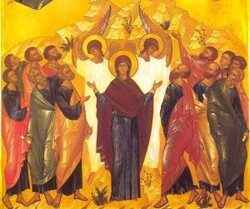|
Forty days after Christ’s resurrection, He was taken up into the Heavens before the disciples, and so forty days after Pascha, falls the Feast of the Ascension. The icon for the feast shows the events as described in the Book of Acts, though as with all Holy Icons there is more revealed than just a straight retelling of the story in pictures. Based on the accounts written by St Luke in his Gospel (Luke 24:36-53) and the Book of Acts (Acts 1:1-12), the icon of the Ascension is correspondingly ancient. One of the earliest surviving images of the Ascension, a full-page illustration from the 6th century Rabbula Gospels, is remarkably similar to all subsequent icons, with precious few variations. Icons from St Catherine’s monastery in Sinai, for example, show little change between images of the Ascension made in the 6th century with those painted almost 600 years later. Regardless of age or location, the Icon of the Ascension seems to have been “canonized” early on in the Church’s history. The Ascension scenes fall naturally into two zones, an upper heavenly part and a lower earthly part and symbolises both confusion and peace: the former is borne of worldly reasoning, whilst the latter comes from divine, heavenly, order. The image itself is characterized by colour: the robes of the Apostles, the Mother of God, the Angels, and Christ Himself surrounded by light; all this being very appropriate this, on of the twelve Great Feasts. In the Holy Scriptures, Jesus is described as being “taken up” into the skies and disappearing from sight behind a cloud. This seems to be at odds with imagery of the icon. Seemingly contrary, the icon of the event shows Christ in glory: surrounded by a mandorla (or circle) of light, flanked by angels, and arrayed in brilliant golden robes. Indeed, the similarity between the appearance of Christ at His Ascension, and the appearance of Christ at His Second Coming are striking! Christ in glory, is often depicted as seated upon a “rainbow”. This comes directly from the Book of Revelation, regarding the Last Judgment and Second Coming of Jesus Christ: Immediately I was in the Spirit; and behold, a throne set in heaven, and One sat on the throne. And He who sat there was like a jasper and a sardius stone in appearance; and there was a rainbow around the throne, in appearance like an emerald. (Rev 4:2-3) The reason Christ ascending into Heaven is depicted the same as Christ’s Second Coming is because of the words of the angels present at the Ascension: “Men of Galilee, why do you stand gazing up into heaven? This same Jesus, who was taken up from you into heaven, will so come in like manner as you saw Him go into heaven.” (Acts 1:11) And so the Icon depicts Jesus’ Ascension and Second Coming “in like manner”. Not that the disciples below Christ fully understand these words yet.  The distinction between heavenly peace and worldly confusion is most apparent upon the Mount of Olives. The Apostles look up in a combination of fear and wonder, their arms waving like the olive trees on the mount. In the centre, the two angels “in white apparel” exhort the men to cease their gazing into heaven and return to Jerusalem to receive the promised gift of the Holy Spirit. Between the two angels stands Mary the Mother of God, hands raised in prayer, not staring up, but peacefully toward us. Already overshadowed by the Holy Spirit since Christ’s conception, Mary appears to understand the deep mysteries of her Son’s birth, death, resurrection and ascension, already hoping on Christ’s return. This hope brings her the divine peace shared by Jesus Christ and the angels: they all have halos signifying the grace and glory of God, whereas the disordered Apostles do not. The Ascension, as well as showing the historical event of Christ’s ascension, also symbolically depicts the Church. This is most evident by the Apostle Paul being present in the icon, despite the Ascension occurring before Paul’s conversion (recounted later in the Book of Acts).This is not an uncommon depiction in holy icons: the icon of Pentecost also shows Paul, as it too is an icon of the Church. The differences and similarities between the two festal icons (the feasts being only 10 days apart) are deliberate. Before the coming of the Holy Spirit the Church is put into a certain amount of confusion by the physical absence of Christ. At Pentecost – by the power of the Holy Spirit – the Church, again represented by the Apostles, is shown in order. And the Apostles get their halos.
0 Comments
Leave a Reply. |
Parish Blog
This mainly contains homilies and messages from our priests, although there is some scope to share thoughts and interesting articles which we may want to share with others Archives
October 2022
Categories |
 RSS Feed
RSS Feed